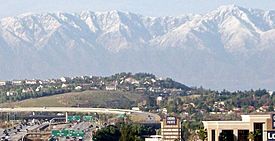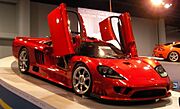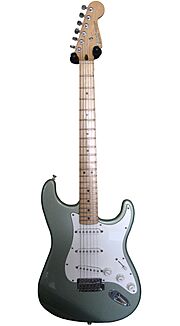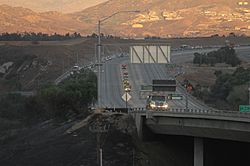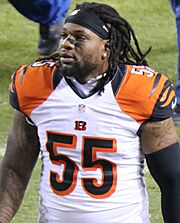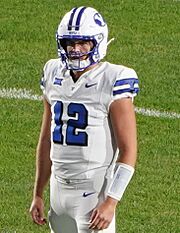Corona, California facts for kids
Quick facts for kids
Corona, California
|
|||
|---|---|---|---|
|
Top: view of Corona; bottom: Corona Historic Civic Center Theater
|
|||
|
|||
| Nicknames:
Crown Town, The Circle City, Crown Colony, Queen Colony, Indianapolis of the West
|
|||
| Motto(s):
"To Cherish Our Past, To Plan Our Future"
|
|||
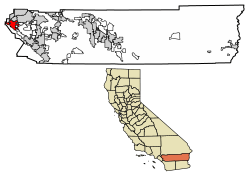
Location of Corona in Riverside County, California
|
|||
| Country | United States | ||
| State | California | ||
| County | Riverside | ||
| Government | |||
| • Type | Council–manager | ||
| Area | |||
| • City | 39.96 sq mi (103.50 km2) | ||
| • Land | 39.94 sq mi (103.45 km2) | ||
| • Water | 0.02 sq mi (0.05 km2) 0.27% | ||
| Elevation | 679 ft (207 m) | ||
| Population
(2020)
|
|||
| • City | 157,136 | ||
| • Rank | 3rd in Riverside County 34th in California 161st in the United States |
||
| • Density | 3,934.20/sq mi (1,519.02/km2) | ||
| • Metro | 4,224,851 | ||
| Time zone | UTC−8 (Pacific) | ||
| • Summer (DST) | UTC−7 (PDT) | ||
| ZIP codes |
92877–92883
|
||
| Area code | 951, 909 | ||
| FIPS code | 06-16350 | ||
| GNIS feature IDs | 1652691, 2410232 | ||
| Website | City Government Tourism site |
||
Corona (Spanish for "Crown") is a city in northwestern Riverside County, California, United States. At the 2020 census, the city had a population of 157,136, up from 152,374 at the 2010 census. Corona is surrounded by Riverside to the east, Norco to the north and northeast, Yorba Linda to the northwest, Cleveland National Forest and the Santa Ana Mountains to the west, southwest, and south. Several unincorporated communities are along the rest of the city's borders. Downtown Corona is approximately 48 miles (77 kilometers) southeast of Downtown Los Angeles and 95 miles (153 km) north-northwest of San Diego.
Corona, located along the western edge of Southern California's Inland Empire region, is known as the "Circle City" due to Grand Boulevard's 3 mi (4.8 km) circular layout. It is one of the most residential cities in the Inland Empire, but also has a large industrial portion on the northern half, being the headquarters of companies such as Fender Musical Instruments Corporation, Monster Beverage Corporation, and supercar manufacturer Saleen.
Contents
Etymology
Corona is Spanish for crown or wreath. Originally called South Riverside, citizens wanted to distinguish their city from the larger city of Riverside to the north. When it came time to incorporate the city a number of different names were considered, but the name Corona was chosen to play upon a unique feature of the city, the one-mile diameter drive that circled the center of the town.
History
Indigenous
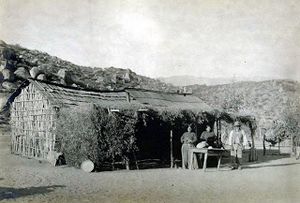
Prior to the late eighteenth century, the area was primarily inhabited by the Tongva and Payómkawichum, who lived in a series of villages throughout the area. What is now Corona stood at the southeastern extent of Tovaangar, or the Tongva world, and at the northern edge of Payómkawichum territory.
The primary settlement in the area was the village of Paxauxa, which was established along the banks of the Temescal Creek at about where Corona is situated today. The settlement was shared by both the Tongva and Payómkawichum people. Cooperation and marriage between the two villages was common. High above the city of Corona, the village of Pamajam was also located in a small valley of the Santa Ana Mountains.
Colonial period

The founding of Mission San Juan Capistrano in 1776 and Mission San Luis Rey in 1798 saw the introduction of Spanish soldiers and missionaries in the area. This resulted in villagers being brought to the mission to be baptized and as labor.
Spanish influence increased in the area with the establishment of the San Antonio de Pala Asistencia in 1816. Two years following the construction of this mission outpost, the Temescal Valley's first European resident, Leandro Serrano, was given permission by the Spanish to use the area for cattle grazing. His first order was to kill the local bear and mountain lion population for the imported herds.
After the secularization of the Spanish missions by the First Mexican Republic in 1833, the land under influence by the missions in Alta California was gradually granted to large landowners as ranches. In 1848, Californio governor Pio Pico issued this land to Bernardo Yorba, which included present-day city of Corona.
Establishment

Corona was founded at the height of the Southern California citrus boom in 1886, and is situated at the upper end of the Santa Ana River Canyon, a significant pass through the Santa Ana Mountains. The town of Corona was once the "Lemon Capital of the World". A museum there presents the lemon's former role in the local economy. The city's name means crown in Spanish due to the circular shape of a crown and the circular shape of Grand Blvd. The nickname of Corona is "The Circle City" from the unique layout of its streets, with a standard grid enclosed by the circular Grand Boulevard, 2.75 miles (4.43 km) in circumference. The street layout was designed by Hiram Clay Kellogg, a civil engineer from Anaheim who was an influential figure in the early development of Orange County.
Corona was established as a town by the South Riverside Land and Water Company. The company was incorporated in 1886; founding members included ex-Governor of Iowa Samuel Merrill, R.B. Taylor, George L. Joy, A.S. Garretson, and Adolph Rimpau. Originally a citrus growers' organization, it purchased the lands of Rancho La Sierra of Bernardo Yorba, and the Rancho Temescal grant and the colony of South Riverside was laid out. They also secured the water rights to Temescal Creek, its tributaries and Lee Lake. Dams and pipelines were built to carry the water to the colony. In 1889, the Temescal Water Company was incorporated, to supply water for the new colony. This company purchased all the water-bearing lands in the Temescal valley and began drilling artesian wells.
Originally located in San Bernardino County, the city was named "South Riverside" and received its post office in that name on either May 27 or August 11, 1887 with Charles H. Cornell as the town's first postmaster. In 1893, South Riverside became part of the new Riverside County. In 1896, the city was renamed "Corona" for its circular Grand Boulevard, where three international automobile races were held in 1913, 1914 and 1916.
20th century
The city of Corona has been popular among celebrities drawn to its upscale areas and relative privacy compared to Los Angeles. Lucille Ball and Desi Arnaz spent time at their ranch, located in north Corona, and played golf often at the Cresta Verde Golf Course in the northeastern section of the city. After their divorce, Arnaz continued to live in Corona.
In recent years Corona has been known as the "Gateway to the Inland Empire". Main Street Realtors wrote, "Prior to the 1980s, the city was largely an agricultural community, dominated by citrus orchards, ranches, and dairy farms. High real estate prices in Los Angeles and Orange counties made the area's land desirable to developers and industrialists, and by the late 1990s Corona was considered a major suburb of Los Angeles."
21st century
In 2002, the city government considered an initiative to secede from Riverside County and form an autonomous Corona County because the city government and some residents were dissatisfied with how services were handled in nearby areas. The effort was also considered by areas in other cities in the western part of the county as far south as Murrieta. Whether nearby cities such as Norco would have been included in the new county are unknown. The proposed county would have been bordered by San Bernardino County to the northwest and by Orange County to the west, but it never came to fruition.
Geography and climate
Corona is located in western Riverside County, east of Orange County.
According to the United States Census Bureau, the city has a total area of 38.9 square miles (101 km2), of which 38.8 square miles (100 km2) of it is land and 0.1 square miles (0.26 km2) of it, or 0.27%, is water.
Corona experiences a warm Mediterranean climate (Köppen climate classification: CSa) and has mild to cool winters and hot summers. Most of the rainfall (as in all of Southern California) occurs during winter and early spring.
Winter days are pleasant, with the average highs staying in the mid to upper 60s. But compared to other areas in Southern California, winter lows are colder, with common frost and chilly mornings. Snowfall within city limits is rare. Snow flurries will occasionally fall, usually once every other year, but it very rarely snows to the point where it accumulates. The nearby Santa Ana Mountains receive a dusting of snow a few times each winter.
Spring brings pleasant weather with daytime temperatures in the mid to upper 70s, and nighttime lows in the upper 40s. Spring showers are common during the beginning of the season but are a rarity by late May.
Summertime is hot, with highs averaging in the low to mid 90s. During the hottest months, daytime temperatures in Corona can exceed 100 °F (38 °C). In early summer, Corona receives common overcast weather known as "May Gray" and "June Gloom". Summer thunderstorms are sporadic and usually happen between July and September from the North American Monsoons, bringing increased humidity and scattered thunderstorms.
Autumn features warm days and sharply cooler evenings, but can be windy due to the Santa Ana winds, blowing in two or three times a year from October to December.
| Climate data for Corona, California | |||||||||||||
|---|---|---|---|---|---|---|---|---|---|---|---|---|---|
| Month | Jan | Feb | Mar | Apr | May | Jun | Jul | Aug | Sep | Oct | Nov | Dec | Year |
| Record high °F (°C) | 91 (33) |
93 (34) |
100 (38) |
100 (38) |
107 (42) |
110 (43) |
118 (48) |
113 (45) |
114 (46) |
108 (42) |
99 (37) |
94 (34) |
118 (48) |
| Mean daily maximum °F (°C) | 66 (19) |
69 (21) |
71 (22) |
77 (25) |
80 (27) |
87 (31) |
92 (33) |
93 (34) |
90 (32) |
83 (28) |
74 (23) |
67 (19) |
79 (26) |
| Mean daily minimum °F (°C) | 40 (4) |
43 (6) |
45 (7) |
48 (9) |
52 (11) |
57 (14) |
62 (17) |
64 (18) |
60 (16) |
52 (11) |
45 (7) |
42 (6) |
51 (11) |
| Record low °F (°C) | 19 (−7) |
25 (−4) |
25 (−4) |
28 (−2) |
28 (−2) |
39 (4) |
41 (5) |
41 (5) |
41 (5) |
29 (−2) |
26 (−3) |
22 (−6) |
19 (−7) |
| Average precipitation inches (mm) | 3.01 (76) |
3.06 (78) |
2.32 (59) |
1.02 (26) |
.35 (8.9) |
.04 (1.0) |
.10 (2.5) |
.12 (3.0) |
.24 (6.1) |
.54 (14) |
1.07 (27) |
2.08 (53) |
13.95 (354) |
| Average precipitation days | 6.9 | 7.0 | 5.5 | 3.7 | 1.2 | 0.3 | 1.0 | 1.2 | 1.7 | 2.2 | 4.1 | 6.2 | 41 |
| Mean monthly sunshine hours | 200 | 210 | 270 | 310 | 305 | 295 | 370 | 350 | 290 | 250 | 210 | 205 | 3,265 |
| Source: The Weather Company | |||||||||||||
Economy
Businesses and organizations with global, national or major regional headquarters in Corona include:
- TCL, a Chinese technology company
- Monster Beverage, a worldwide manufacturer of soft drinks, including Hansen's beverages and the Monster Energy drink line.
- Circle K, an international convenience store chain.
- Saleen, manufacturer of specialty, high-performance sports cars.
- Fender, world-famous manufacturer of electric guitars, amplifiers, and musical equipment. The Fender Custom Shop is also based in the same building.
- Zumiez, youth and action sports clothing and accessory retailer. Corona is home to the Zumiez distribution center.
- Troy Lee Designs, makers of various motocross and mountain bike accessories and apparel.
- LuLaRoe, controversial and legally embattled multi-level marketing distributor of women's apparel.
- Sterno, manufacturers of portable cooking fuel.
- SPJA (Society for the Promotion of Japanese Animation), a 501(c)3 non-profit organization that promotes the Japanese anime industry and related cultures. The SPJA is the organizer for Anime Expo, the largest anime convention in North America.
Top employers
According to the city's 2024 Comprehensive Annual Financial Report, the top employers in the city are:
| # | Employer | # of Employees |
|---|---|---|
| 1 | Corona-Norco Unified School District | 5,478 |
| 2 | Corona Regional Medical Center | 1,265 |
| 3 | Monster Energy | 1,075 |
| 4 | City of Corona | 961 |
| 5 | Fender USA Corona | 955 |
| 6 | TWR Framing Enterprises | 800 |
| 7 | All American Asphalt | 755 |
| 8 | Veg Fresh Farms | 527 |
| 9 | Thermal Structures | 392 |
| 10 | Kaiser Permanente | 286 |
Demographics
| Historical population | |||
|---|---|---|---|
| Census | Pop. | %± | |
| 1900 | 1,434 | — | |
| 1910 | 3,540 | 146.9% | |
| 1920 | 4,129 | 16.6% | |
| 1930 | 7,018 | 70.0% | |
| 1940 | 8,764 | 24.9% | |
| 1950 | 10,223 | 16.6% | |
| 1960 | 13,336 | 30.5% | |
| 1970 | 27,519 | 106.4% | |
| 1980 | 37,791 | 37.3% | |
| 1990 | 76,095 | 101.4% | |
| 2000 | 124,966 | 64.2% | |
| 2010 | 152,374 | 21.9% | |
| 2020 | 157,136 | 3.1% | |
| U.S. Decennial Census | |||
2020
| Race / Ethnicity (NH = Non-Hispanic) | Pop 2000 | Pop 2010 | Pop 2020 | % 2000 | % 2010 | % 2020 |
|---|---|---|---|---|---|---|
| White alone (NH) | 58,784 | 58,087 | 49,860 | 47.04% | 38.12% | 31.73% |
| Black or African American alone (NH) | 7,704 | 8,333 | 8,136 | 6.16% | 5.47% | 5.18% |
| Native American or Alaska Native alone (NH) | 490 | 422 | 461 | 0.39% | 0.28% | 0.29% |
| Asian alone (NH) | 9,239 | 14,650 | 18,482 | 7.39% | 9.61% | 11.76% |
| Pacific Islander alone (NH) | 353 | 496 | 509 | 0.28% | 0.33% | 0.32% |
| Some Other Race alone (NH) | 278 | 272 | 822 | 0.22% | 0.18% | 0.52% |
| Mixed Race or Multi-Racial (NH) | 3,549 | 3,667 | 5,764 | 2.84% | 2.41% | 3.67% |
| Hispanic or Latino (any race) | 44,569 | 66,447 | 73,102 | 35.66% | 43.61% | 46.52% |
| Total | 124,966 | 152,374 | 157,136 | 100.00% | 100.00% | 100.00% |
2010
| Ancestry in Corona | ||||
|---|---|---|---|---|
| Origin | percent | |||
| Mexican American | 33.7% | |||
| German American | 11.1% | |||
| Irish American | 7.0% | |||
| English American | 6.7% | |||
| African American | 5.9% | |||
| Multiracial American | 5.1% | |||
| Italian American | 4.0% | |||
| French American | 2.7% | |||
| Filipino American | 2.3% | |||
| Vietnamese American | 2.1% | |||
| Puerto Rican American | 2.1% | |||
| Korean American | 1.7% | |||
| Polish American | 1.6% | |||
| Indian American | 1.4% | |||
| Other | 18.1% | |||
The 2010 United States Census reported that Corona had a population of 152,374. The population density was 3,914.0 inhabitants per square mile (1,511.2/km2). The racial makeup of Corona was 90,925 (59.7%) White (40.1% Non-Hispanic White), 8,934 (5.9%) African American, 1,153 (0.8%) Native American, 16,205 (10.6%) Asian, 552 (0.4%) Pacific Islander, 28,003 (18.4%) from other races, and 7,759 (5.1%) from two or more races. Hispanic or Latino of any race were 66,447 persons (41.9%); 33.7% of Corona's population are Mexican-American, 2.1% Puerto Rican, 1.2% Cuban, 1.2% Salvadoran, 1.1% Guatemalan, 0.5% Colombian, 0.5% Peruvian, 0.5% Argentine, 0.3% Honduran, 0.2% Nicaraguan, and 0.2% Ecuadorian. Among Asian-Americans, 2.3% of Corona's population were Filipino, 2.1% Vietnamese, 1.7% Korean, 1.4% Indian-Americans, 1.1% Chinese, 0.7% Japanese, 0.4% Pakistani, 0.2% Thai, and 0.1% Bangladeshi. The second largest group of Corona's population is made up of White Americans; the largest groups were 11.1% German-American, 6.7% Irish, 6.2% English, 4.0% Italian, 2.7% French, 1.6% Polish, 1.3% Dutch, 1.2% Norwegian, 1.1% Scottish, 1.1% Swedish.
The Census reported that 151,863 people (99.7% of the population) lived in households, 229 (0.2%) lived in non-institutionalized group quarters, and 282 (0.2%) were institutionalized.
There were 44,950 households, out of which 22,735 (50.6%) had children under the age of 18 living in them, 27,357 (60.9%) were opposite-sex married couples living together, 5,971 (13.3%) had a female householder with no husband present, 3,004 (6.7%) had a male householder with no wife present. There were 2,690 (6.0%) unmarried opposite-sex partnerships, and 360 (0.8%) same-sex married couples or partnerships. 6,455 households (14.4%) were made up of individuals, and 2,224 (4.9%) had someone living alone who was 65 years of age or older. The average household size was 3.38. There were 36,332 families (80.8% of all households); the average family size was 3.72.
The population was spread out, with 45,674 people (30.0%) under the age of 18, 15,504 people (10.2%) aged 18 to 24, 44,215 people (29.0%) aged 25 to 44, 35,801 people (23.5%) aged 45 to 64, and 11,180 people (7.3%) who were 65 years of age or older. The median age was 32.5 years. For every 100 females, there were 97.0 males. For every 100 females age 18 and over, there were 94.5 males.
There were 47,174 housing units at an average density of 1,211.8 units per square mile (467.9 units/km2), of which 30,210 (67.2%) were owner-occupied, and 14,740 (32.8%) were occupied by renters. The homeowner vacancy rate was 2.3%; the rental vacancy rate was 5.3%. 103,170 people (67.7% of the population) lived in owner-occupied housing units and 48,693 people (32.0%) lived in rental housing units.
During 2009–2013, Corona had a median household income of $77,123, with 10.8% of the population living below the federal poverty line.
2000
As of the census of 2000, there were 124,996 people, 37,839 households, and 30,384 families residing in the city. The population density was 3,555.5 inhabitants per square mile (1,372.8/km2). There were 39,271 housing units at an average density of 1,117.3 units per square mile (431.4 units/km2). The racial makeup of the city was 75.0% White, 6.4% Black or African American, 0.9% Native American, 7.5% Asian, 0.3% Pacific Islander, 17.5% from other races, and 5.3% from two or more races. 25.5% of the population were Hispanic or Latino of any race.
There were 37,839 households, out of which 49.6% had children under the age of 18 living with them, 63.8% were married couples living together, 11.2% had a female householder with no husband present, and 19.7% were non-families. 14.4% of all households were made up of individuals, and 3.8% had someone living alone who was 65 years of age or older. The average household size was 3.3 and the average family size was 3.6.
In the city, the population was spread out, with 33.4% under the age of 18, 8.9% from 18 to 24, 35.1% from 25 to 44, 16.8% from 45 to 64, and 5.8% who were 65 years of age or older. The median age was 30 years. For every 100 females, there were 98.0 males. For every 100 females age 18 and over, there were 95.6 males.
The median income for a household in the city was $98,615, and the median income for a family was $83,505 (these figures had risen to $88,620 and $95,450 respectively as of a 2007 estimate). Males had a median income of $44,752 versus $31,884 for females. The per capita income for the city was $21,001. About 6.0% of families and 8.3% of the population were below the poverty line, including 10.1% of those under age 18 and 7.3% of those age 65 or over.
Infrastructure
Transportation
The city's downtown area is circled by Grand Boulevard, which is unique for being perfectly circular. The street is approximately 1 mi (1.6 km) in diameter.
The city is served by the Corona (SR 71), Interstate 15 (I-15), and Riverside (SR 91) freeways.
There is a proposal to erect a new four-lane freeway along or near Cajalco Road to connect Interstates 15 and 215, although the plan remains controversial. In addition, there is a possibility of constructing a 7.5 mi (12.1 km) tunnel under the Santiago Peak Mountains to the Eastern Transportation Corridor of the FastTrak toll-road company system in Orange, due to increased commuter traffic on State Route 91, which needs to be reduced by another freeway between Orange and Riverside counties.
Corona Municipal Airport (FAA designator: AJO) serves the city and has a 3,200-foot (980 m) runway. On January 20, 2008, two small passenger aircraft collided over Corona, killing all four men aboard the planes and another man on the ground. In the past ten years, there have been five fatal plane crashes around Corona.
Public transportation

The city is linked with the 91/Perris Valley Line and Inland Empire–Orange County Line of the Metrolink commuter rail system, providing service to Los Angeles, Perris, San Bernardino, and Oceanside from Corona–North Main station in the Downtown area and Corona–West station in Corona's west side.
The City of Corona operates its own transportation system called the Corona Cruiser. It consists of two circular routes around the city.
Corona's public transportation also includes the following bus lines: RTA route 1 from West Corona to UC Riverside, RTA route 3 from Corona Regional Medical Center to Swan Lake in nearby Eastvale, RTA route 214 from Downtown Corona to The Village shopping center in Orange, RTA route 206 from Downtown Corona to Temecula, OCTA bus route from Anaheim to South Corona Walmart (Ontario Avenue), and the Corona Cruiser blue and red lines.
Healthcare
Corona is served by the following three hospitals:
- The Corona Regional Medical Center, a General Acute Care Hospital with Basic Emergency Services as of 2005
- Kaiser Permanente Corona (no emergency services)
- Corona Regional Rehabilitation Hospital
(emergency services) the city of Corona's fire and emergency medical services are provided by the Corona fire department, with emergency transport being provided by American Medical Response. law enforcement is provided by the city of corona police department, along with the Riverside county sheriff's office.
Education
The city of Corona is a part of the Corona-Norco Unified School District and the Alvord Unified School District. Corona-Norco serves the majority of the city while Alvord serves a small section of eastern Corona.
There are five high schools in Corona: Corona, Centennial, Lee V. Pollard, Orange Grove, Santiago. There are five middle schools in Corona: Auburndale, Citrus Hills, Corona Fundamental, El Cerrito, Raney.
There are also 28 elementary schools in the city: John Adams, Susan B. Anthony, Cesar Chavez, Corona Ranch, Coronita, Dwight Eisenhower, Foothill, Ben Franklin, Garretson, Home Gardens, Jefferson, Lincoln Alternative, William McKinley, Orange, Parkridge, Prado View, Promenade, Riverview, Ronald Reagan, Sierra Vista, Stallings, Temescal Valley, Dr. Bernice Todd, Vandermolen, Vicentia, Victress Bower, George Washington and Woodrow Wilson.
Private schools include St. Edward Catholic School and Crossroads Christian School.
Nonprofit associations
The World Mosquito Control Association (WMCA) is located in Corona.
Utilities
Southern California Edison provides most of the city's electricity and a small part of the city is serviced by Corona Department of Water and Power. Waste Management Inc. provides waste disposal for the city. Southern California Gas Company provides natural gas services.
Cemetery
The Corona Sunnyslope Cemetery is a for-profit cemetery established in 1892. Notable burials include USC Trojans athletic director Jess Hill.
Corrections
California Institution for Women of the California Department of Corrections and Rehabilitation has a "Corona, CA" mailing address, but is in the City of Chino.
Neighborhoods
Center City
Downtown District
Centered around Grand Boulevard Historic District (GBHD), Downtown District is the oldest area of the city by far, and encompasses portions of the neighborhoods of Civic Center and Circle City along with the entirety of GBHD.
North Main Street District
The area north of Grand Boulevard Circle centered around N Main St, named North Main Street District, underwent drastic rebranding, redevelopment, and repair beginning in 2017, particularly on the west side of N Main St. Metro at Main - a large mixed-use development featuring apartments atop retail with additional retail along the property - is a commuter community due to its close proximity to Metrolink's Corona - North Main Station, and both SR 91 and I-15 freeways. The east side of N Main St - particularly E Harrison St and E Blaine ST between N Main St and N Joy St - will be converted to a mixed-use community featuring apartments and retail, further making use of the close proximity to Corona - North Main Station.
Historic South Main Street Palms District
Beginning at the intersection of S Main St and Olive St - one block south of the Grand Boulevard Circle - Historic South Main Street Palms District is a long stretch of varying species of palms that were planted and integrated into the landscaping plan for South Corona in the early 20th century. It includes all of the houses and businesses along S Main St between Olive St and Chase Dr.
Unincorporated communities
After the boom in housing growth that occurred in Corona in the early 2000s, many previously more isolated communities have come to be completely or mostly surrounded by Corona. They are within the Corona sphere of influence; however, they have not been annexed by the city yet due to unpopular annexation referendums among other reasons. Services are provided by the County of Riverside. These communities are Coronita, El Cerrito, Home Gardens, and Temescal Valley, with Temescal Valley having many sub=communities within it such as Arcilla, Glen Eden Sun Club, Glen Ivy, Sycamore Creek, Terramor, and Trilogy. Overall, almost 50,000 people live in these unincorporated communities.
| Neighborhood | Type | Area
(Sq Mi) |
Rank by Size | Adoption Date | Minor Neighborhoods | District Overlays | General/Specific Plan |
|---|---|---|---|---|---|---|
| Downtown District | Mixed-Use Downtown | 0.979 sq mi | N/A
District Overlay |
Overlays the following neighborhoods:
Circle City (partially); Civic Center (partially); Grand Boulevard Historic District (entirely) |
Downtown Revitalization Specific Plan | |
| Grand Boulevard Historic District | Mixed-Use Downtown | 0.652 sq mi | #24 / 51 | Merrill Park, Ramona, Sheridan Park, Victoria Park | ||
| South Main Street Palm Trees Historic District | Mixed-Use Residential | 0.091 sq mi | N/A
District Overlay |
Overlays slight portions of the following neighborhoods:
Buena Vista, Kellogg, Husted Park, Mountain Gate East, Taylor |
||
| North Main Street District | Mixed-Use Commercial | 0.397 sq mi | N/A District Overlay | January 5, 2000 | Overlays portions of the following neighborhoods:
North Main East, North Main West |
North Main Street Specific Plan |
Eastside
| Neighborhood | Type | Area
(Sq Mi) |
Rank by Size | Adoption Date | Minor Neighborhoods | District Overlays | General/Specific Plan |
|---|---|---|---|---|---|---|
| Cimarron | Mixed-Use Residential | 0.17 sq mi | #50 / 51 | July 1996 | Cimarron Estates, The Cimarron | The Cimarron Specific Plan |
| Corona Hills | Mixed-Use Residential | 2.91 sq mi | #1 / 51 | January 20, 1982 | Cresta Verde, Cresta Verde Heights, East McKinley, Griffin Heights, Northeast Commercial Corridor, Promenade Heights, Tehachapi, West McKinley | Northeast Corona Specific Plan |
| Corona Ranch | Residential | 1.12 sq mi | #10 / 51 | November 20, 1985 | Parkview, Ranch Vista, Village Park, West Ridge | Corona Ranch Specific Plan |
| North Main East | Mixed-Use Commercial-Industrial | 0.461 sq mi | #32 / 51 | January 5, 2000
September 7, 2011 |
Birtcher Business Center, North Main Street District (Overlay) | North Main Street District Specific Plan
Birtcher Business Center Specific Plan |
| Parkridge | Residential | 0.198 sq mi | #48 / 51 |
| Neighborhood | Type | Area
(Sq Mi) |
Rank by Size | Adoption Date | Minor Neighborhoods | District Overlays | General/Specific Plan |
|---|---|---|---|---|---|---|
| Bel Air | Residential | 0.182 sq mi | #49 / 51 | Bel Air Estates, Monte Olivo | ||
| Circle City | Mixed-Use Residential | 0.392 sq mi | #35 / 51 | Circle City Bottoms, City Park Historic District (Overlay), Corona Quarry, Downtown District (Overlay) | ||
| Corona Magnolia | Mixed-Use
Commercial-Industrial |
0.939 sq mi | #14 / 51 | September 2002 | Corona Magnolia Specific Plan | |
| Eagle Valley | Undeveloped | 2.22 sq mi | #3 / 51 | |||
| Kellogg Village | Residential | 0.488 sq mi | #28 / 51 | Garretson Village, South Main St Palm Trees Historic District (Overlay), Kellogg Park | ||
| Pepper Corner | Mixed-Use Residential | 1.02 sq mi | #12 / 51 | Avian Corner, Centennial Heights, Magnolia Medical Center, Rimpau Ave Palm Trees Historic District (Overlay) | ||
| Sunnyslope | Mixed-Use Residential | 0.654 sq mi | #23 / 51 | Park-Ford, Sunnyslope Cemetery & Potters Field Historic District (Overlay), Wood Streets | ||
| Temescal Canyon | Mining | 1.49 sq mi | #7 / 51 |
| Neighborhood | Type | Area
(Sq Mi) |
Rank by Size | Adoption Date | Minor Neighborhoods | District Overlays | General/Specific Plan |
|---|---|---|---|---|---|---|
| Arantine Hills | Mixed-Use Residential | 0.852 sq mi | #18 / 51 | August 2012 | Bedford | Arantine Hills Specific Plan |
| Cajalco Gateway | Mixed-Use Commercial-Industrial | 0.61 sq mi | #25 / 51 | May 1, 2002 | El Cerrito Specific Plan (SPA01-012) | |
| Chase Ranch | Mixed-Use Residential | 0.814 sq mi | #20 / 51 | September 20, 1989 | Ashwood, Chase Ranch North, Chase Ranch South | Chase Ranch Specific Plan |
| Cherokee | Mixed-Use Residential | 0.303 sq mi | #40 / 51 | July 11, 1990 | Cherokee Hill, Corona Cerrito North, Corona Cerrito South | Cherokee Specific Plan |
| Corona Vista | Mixed-Use Residential | 1.03 sq mi | #11 / 51 | September 19, 1990 | Montverde, Ramsgate, Rimpau Ave Palm Trees Historic District (Overlay) | Corona Vista Specific Plan |
| Dos Lagos | Mixed-Use Residential | .0919 sq mi | #16 / 51 | June 21, 2000 | Citrus Springs, Owens Cove, Temescal Heights | Dos Lagos Specific Plan |
| Eagle Glen | Mixed-Use Residential | 1.89 sq mi | #4 / 51 | October 2, 1991 | Edgewood, Village Crest | Eagle Glen Specific Plan |
| Empire | Residential | 0.384 sq mi | #37 / 51 | August 28, 1990 | California Heights | Empire Homes Specific Plan |
| Mountain Gate East | Mixed-Use Residential | 0.846 sq mi | #19 / 51 | June 7, 1989 | South Main St Palm Trees Historic District (Overlay) | Mountain Gate Specific Plan |
| Santana Heights | Mixed-Use Residential | 0.771 sq mi | #21 / 51 | Garretson Estates, Chase Drive Palm Trees Historic District (Overlay), Kammeyer Ranch Historic District (Overlay), Orange Heights, South Main Street Palm Trees Historic District (Overlay) | ||
| South Cleveland | Residential | 0.991 sq mi | #13 / 51 | September 2002 | Bella Vista Estates, Crown Ranch Estates, Renaissance Estates, Seven Oaks | Crown Ranch Estates Specific Plan |
Westside
| Neighborhood | Type | Area
(Sq Mi) |
Rank by Size | Adoption Date | Minor Neighborhoods | District Overlays | General/Specific Plan |
|---|---|---|---|---|---|---|
| Auburndale | Mixed-Use Residential | 1.28 sq mi | #9 / 51 | Central Auburndale, Fairview, River Road, Stagecoach | ||
| Corona Airport & Flood Zone | Flood Control Zone | 1.56 sq mi | #6 / 51 | |||
| Corona Westgate | Mixed-Use Commercial | 0.259 sq mi | #43 / 51 | May 20, 1987 | Corona Westgate Specific Plan | |
| North Main West | Mixed-Use Residential-Commercial | 0.355 sq mi | #38 / 51 | January 5, 2000 | Corona Corporation Yard Complex, North Main Street District (Overlay), North Main West Industrial Park | |
| Northwest Industrial District | Mixed-Use Commercial-Industrial | 1.84 sq mi | #5 / 51 | Butterfield Park, Commerce, Enterprise | ||
| Railroad | Mixed-Use Residential | 0.298 sq mi | #41 / 51 | Contreras Park, NoRa (North of Railroad St) |
| Neighborhood | Type | Area
(Sq Mi) |
Rank by Size | Adoption Date | Minor Neighborhoods | District Overlays | General/Specific Plan |
|---|---|---|---|---|---|---|
| Brentwood North | Residential | 0.477 sq mi | #29 / 51 | Brentwood Park, Saint Matthew's North | ||
| Brentwood South | Residential | 0.408 sq mi | #34 / 51 | Border Park, Saint Matthew's South | ||
| Brookwood | Residential | 0.219 sq mi | #45 / 51 | February 5, 1986 | Brookwood Specific Plan | |
| Civic Center | Mixed-Use Residential | 0.206 sq mi | #46 / 51 | Downtown District (Overlay), Fifth Street Village, Seventh Street Bottoms | ||
| Corona West | Mixed-Use Residential | 0.593 sq mi | #26 / 51 | Avenida, Pleasant View, Sherman Village, Smith Triangle, Yorba Heights | ||
| Lincoln Park | Residential | 0.892 sq mi | #17 / 51 | ELi (East of Lincoln Ave), WeLi (West of Lincoln Ave) | ||
| Husted Park | Residential | 0.141 sq mi | #51 / 51 | Jefferson, Merrill Park West, South Main St Palm Trees Historic District (Overlay) | ||
| Taylor | Residential | 0.386 sq mi | #36 / 51 | South Main St Palm Trees Historic District (Overlay) | ||
| Village Grove | Mixed-Use Residential | 0.256 sq mi | #44 / 51 |
| Neighborhood | Type | Area
(Sq Mi) |
Rank by Size | Adoption Date | Minor Neighborhoods | District Overlays | General/Specific Plan |
|---|---|---|---|---|---|---|
| Buena Vista | Mixed-Use Residential | 0.469 sq mi | #31 / 51 | South Main St Palm Trees Historic District (Overlay) | ||
| Crown Ridge | Residential | 0.209 sq mi | #46 / 51 | Crown Villas | ||
| Heritage Hills | Residential | 0.425 sq mi | #33 / 51 | Heritage Hill, Mangular Hill (Duckville) | ||
| Highgrove | Residential | 0.313 sq mi | #39 / 51 | September 2, 1992 | Todd Ranch | Todd Ranch Specific Plan |
| Mountain Gate West | Mixed-Use Residential | 1.42 sq mi | #8 / 51 | June 7, 1989 | Mountain Gate Specific Plan | |
| Oak Creek | Residential | 0.475 sq mi | #30 / 51 | Oak Avenue Estates, Marvin Tract | ||
| Skyline | Mixed-Use Residential | 0.933 sq mi | #15 / 51 | Orchard Glen, Skyline Heights, Skyline Village |
| Neighborhood | Type | Area
(Sq Mi) |
Rank by Size | Adoption Date | Minor Neighborhoods | District Overlays | General/Specific Plan |
|---|---|---|---|---|---|---|
| Green River | Mixed-Use Residential | 0.71 sq mi | #22 / 51 | Green River East, Green River Village, Green River West | ||
| Green River Ranch | Undeveloped | 0.278 sq mi | #42 / 51 | February 21, 2001 | Green River Ranch Specific Plan | |
| Sierra Bella | Residential | 0.574 sq mi | #27 / 51 | August 17, 2005 | Sierra Bella Specific Plan | |
| Sierra Del Oro | Mixed-Use Residential | 2.45 sq mi | #2 / 51 | September 18, 1985 | Dominguez Ranch, Prado View, Serfas Club Park, Sierra Palisades | Sierra Del Oro Specific Plan |
Arts and culture
Performing arts
The Arts Alive Council is a non-profit organization created with the purpose to "foster, promote, and increase the public knowledge and appreciation of the arts and cultural activities in the greater Corona Area." Members include the Corona Symphony Orchestra, Circle City Chorale, Christian Arts and Theater, and Corona Dance Academy.
Off Broadway Corona Theater (OBCTheater) is a non-profit organization. They produce two to three theatrical productions each year that are presented at the Corona Civic Center Auditorium.
Notable people
Athletes
- Brendan Beck – Major League Baseball (MLB) pitcher for New York Yankees
- Tristan Beck – MLB pitcher for San Francisco Giants
- Erica Blasberg (1984–2010) – LPGA golfer
- Vontaze Burfict – football linebacker
- Mike Caffey – Point guard for Crailsheim Merlins of the Basketball Bundesliga.
- Courtney Crone – racing driver
- Mike Darr – MLB outfielder
- Richard Dornbush – figure skater
- Heath Farwell – football linebacker and coach
- Troy Glaus – former MLB baseball player Los Angeles Angels
- Matt Kalil – football offensive lineman who is currently a free agent
- Ryan Kalil – football offensive lineman for the New York Jets
- Joe Kelly – MLB relief pitcher
- Denny Lemaster (born 1939) – MLB pitcher
- Jason Martin (born 1995) – MLB outfielder
- Taylor Martinez – former quarterback for Nebraska Cornhuskers
- Taryne Mowatt – All-American softball pitcher for Arizona Wildcats and two-time ESPY Award winner
- Ricky Nolasco – MLB pitcher for Los Angeles Angels
- Lonie Paxton – former NFL player for New England Patriots and Denver Broncos
- Jake Retzlaff – college American football quarterback
- Chance Sisco – MLB baseball player for Baltimore Orioles
- D. J. Strawberry – professional basketball player
- Sean Strickland – professional mixed martial artist and former UFC Middleweight Champion
- Brice Turang – MLB baseball player for Milwaukee Brewers
- Allison Veloz, professional soccer player for Necaxa
- Marcus Alan Williams – football safety for the New Orleans Saints
- Ethan Zubak – soccer player for Nashville SC
Entertainers
- Travis Barker (born 1975) – drummer for Blink-182, Boxcar Racer, The Transplants, and +44
- Larissa "Bootz" Hodge – reality television participant, Flavor of Love 2, Flavor of Love Girls: Charm School
- Tyler Hoechlin – actor known for his role as Derek Hale in Teen Wolf and Superman/Clark Kent in Superman & Lois
- Candy Johnson – dancer and singer in 1960s American International Pictures "beach" movies
- Kerry King (born 1964) – guitarist for Slayer
- Nikki Leonti – singer-songwriter, actress
- Crystal Lewis – Christian music singer, TV actress
- Michael Parks – actor, Kill Bill, Red State, The Happening and other films
- Asia Monet Ray – dancer, recording artist, former Dance Moms cast member
- Jenni Rivera – vocalist, songwriter of banda music
- Jodie Sweetin – actress known for her role as Stephanie Tanner on television sitcoms Full House and Fuller House
- Lil Xan – rapper
Other
- Ken Calvert – United States Representative
- Cirilo Flores – Roman Catholic bishop
- Alex Harvill (1992–2021) – motorcycle stunt performer
- Shawn Ray – former professional bodybuilder and author
- Gary Webb – investigative journalist
Sister cities
The following are Corona's sister cities as designated by Sister Cities International.
See also
 In Spanish: Corona (California) para niños
In Spanish: Corona (California) para niños


